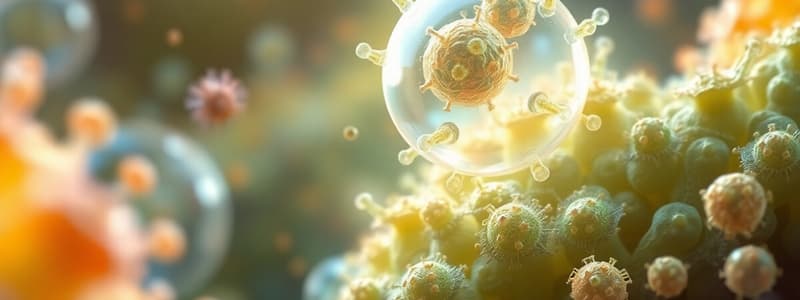Podcast
Questions and Answers
What percentage of known bacterial species are considered true pathogens?
What percentage of known bacterial species are considered true pathogens?
- 10%
- 3% (correct)
- 87%
- 25%
Which branch of microbiology focuses on the study of fungi and yeast?
Which branch of microbiology focuses on the study of fungi and yeast?
- Phycology
- Bacteriology
- Mycology (correct)
- Virology
What is the main focus of virology?
What is the main focus of virology?
- Study of bacteria
- Study of parasites
- Study of viruses (correct)
- Study of fungi
What role do opportunistic pathogens play in the human body?
What role do opportunistic pathogens play in the human body?
Which discipline studies the relationship between host and parasite?
Which discipline studies the relationship between host and parasite?
What is microbiology primarily concerned with?
What is microbiology primarily concerned with?
Who is known as the 'Father of Microbiology'?
Who is known as the 'Father of Microbiology'?
Which branch of microbiology focuses on fungi?
Which branch of microbiology focuses on fungi?
Which discovery is attributed to Sir Alexander Fleming?
Which discovery is attributed to Sir Alexander Fleming?
What did Louis Pasteur demonstrate regarding microorganisms?
What did Louis Pasteur demonstrate regarding microorganisms?
Flashcards are hidden until you start studying
Study Notes
What is Microbiology?
- The study of microscopic living organisms
- Derived from Greek words "micros" (small), "bios" (life), and "logos" (science)
- Requires magnification tools like microscopes
Characteristics of Microorganisms
- Very small, invisible to the naked eye
- Unicellular, one cell capable of performing all functions
- Ubiquitous (found everywhere): on bodies, plant surfaces, air, water, soil, inside animals and insects
Brief History of Microbiology
- Spontaneous generation theory: microbes arise from non-living matter
- Pioneers:
- Antony van Leeuwenhoek (1632): First useful microscopes
- Robert Hooke (1665): Observed and drew plant cell and microbe structures
- Louis Pasteur (1822): Proved microbes are in the air
- Heated broth in sealed flask – no growth
- Heated broth in unsealed flask – growth
- Robert Koch and colleagues: Developed techniques for pure culture of bacteria and fungi
- Paul Ehrlich: Synthesized the first drug against syphilis
- Gerhardt Domagk: Developed the first effective drug against bacterial infections (sulfa drug)
- Sir Alexander Fleming: Discovered penicillin, the first antibiotic
- Waksman: Discovered streptomycin and other antibiotics
Branches of Microbiology
- Bacteriology: Study of bacteria, including their types, characteristics, diseases, and applications
- Medical, industrial, and agricultural bacteriology
- Mycology: Study of fungi and yeast, including their types, characteristics, diseases, and applications
- Medical, industrial mycology
- Applications include antibiotic production, baking, and dairy products
- Phycology: Study of algae, found in various environments
- Floating in oceans and aquatic environments
- Parasitology: Study of parasites, including their relationship with hosts
- Protozoa (amoeba) and Helminths (worms) are major human and animal infection causes
- Virology: Study of viruses, which are non-cellular microbes that require living cells to multiply
- Viruses are seen only under electron microscopes
- Responsible for diseases like AIDS, common cold, SARS, hepatitis, COVID
- Immunology: Study of the immune system of organisms and its response to pathogens
Microbes and Disease
- Although microbes are often associated with disease, the majority are beneficial
- 87% of known bacteria species are beneficial
- 10% are opportunistic pathogens, causing disease only under certain conditions
- Only 3% are true pathogens
Studying That Suits You
Use AI to generate personalized quizzes and flashcards to suit your learning preferences.




